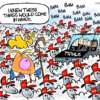After the birth of her second child in 2021, Lucy’s husband emailed a family pediatrician because he knew something wasn’t right.
For privacy reasons, Lucy told the Colorado Times Recorder she only wanted her first name used in the article.
Lucy had no issues with her first child and said going from one to two children was significantly more complicated in terms of sleep and nursing, especially after the pandemic.
“So, I think a lot of it was just the go, go, go of, ‘Okay, you have a baby. Get back on your feet, get back to work after 12 weeks, do all these things for your family, continue to feed your baby, and also don’t sleep,” she said in an interview.
Lucy was diagnosed with postpartum depression (PPD) three months after her daughter’s birth. She was prescribed Zoloft, a Selective Serotonin Reuptake Inhibitor (SSRI) that is less likely to be secreted into one’s breast milk supply.
PPD is a relatively common depressive disorder that women experience after having a child. Symptoms include irritability, tiredness, feelings of emptiness, and, in more severe cases, attempts to harm themselves or their baby. About one in 10 women experience PPD.
While Lucy said she was grateful to take Zoloft, the medication “just didn’t do it” for her. It made her world “dull and boring.”
After she heard a story on Colorado Public Radio about Moms on Mushrooms, a private community that seeks to destigmatize the use of psychedelics for mothers and offers a safe space to discuss their psychedelic journeys, her interest in microdosing psychedelics to combat her PPD deepened.
She then had a four-week cancer scare, which turned out to be strange blood work, but said her doctor was incredibly supportive of her taking psychedelics.
“A cancer doc, in particular, is much more open to these measures or this plant medicine because it can be so supportive for people dealing with terminal cancer or facing a diagnosis that could kill you,” she said, removing two capsules filled with a fine brown powder from her pocket and rolling them gently between her fingers.
The support from her oncologist and pediatrician highlighted the shift in Western society’s perception of psychedelics.
The use of psychedelic substances for ceremonial, religious, or healing purposes can be traced back to indigenous communities across the globe. Some plant-based psychedelic substances include ayahuasca, iboga, peyote, and bufotenin (the world’s oldest psychedelic).
With psychedelics being pushed as dangerous by former President Richard Nixon’s war on drugs and the “loose standards applied to all kinds of drug research in the 1950s and early 1960s,” early psychedelics research was halted.
The Federal Drug Administration (FDA) defines psychedelics as “classic psychedelics, typically understood to be 5-HT2 agonists such as psilocybin and lysergic acid diethylamide (LSD), as well as entactogens or empathogens such as methylenedioxymethamphetamine (MDMA).”
Psilocybin is a naturally occurring psychedelic compound typically consumed for a hallucinogenic effect. Taking psilocybin can induce feelings of euphoria, a change in consciousness, and visual and auditory hallucinations. Someone might experience nausea, vomiting, and anxiety in more adverse reactions.

The FDA classifies psychedelics as “Schedule I,” drugs that are highly addictive and do not have currently accepted medical use. Other Schedule I drugs include marijuana, LSD, heroin, and methylenedioxymethamphetamine (ecstasy).
But now, a growing amount of research is being conducted, with federal government approval, on the medical benefits of psychedelic substances.
The Multidisciplinary Association for Psychedelic Studies (MAPS) –– a non-profit that pushes for medical, legal, and cultural shifts surrounding the safe usage of psychedelics and marijuana –– has conducted multiple studies on substances like marijuana, LSD, and ayahuasca.
In a recent 200-page report examining the usage of MDMA-assisted therapy “for patients with chronic psychiatric disorders such as Posttraumatic Stress Disorder (PTSD), social anxiety, and anxiety related to terminal illnesses,” MAPS found that participants experienced “durable improvements in PTSD symptom severity” within the last 12 months after the previous dosing session.
Oregon was the first state to legalize the adult use of psychedelics on Jan. 1, 2023, and Coloradans passed the Decriminalization and Regulated Access Program for Certain Psychedelic Plants and Fungi Initiative –– also called Prop. 122 –– in November 2022.
Prop. 122 decriminalized the possession of psilocybin mushrooms for adults and allowed “state-licensed treatment centers to administer the drug under the supervision of trained staff,” CPR News reported. The state is developing the regulatory framework for the treatment centers, and the first set of regulations is due by Sept. 30.

And after Prop. 122 was passed, many Coloradans saw it as an opportunity to begin microdosing psychedelics legally.
While there is no concrete definition for a microdose, the New York Times reported that a microdose “is typically defined by experts as taking 5 percent to 10 percent of a full dose of a psychedelic, usually LSD or psilocybin, as a way to get the supposed mental health benefits of the drug without the hallucinogenic high.”
Lucy explained how there are multiple types of doses. “You can microdose, you can mini dose, you can, you know, take a museum dose, there’s all these different levels. Microdosing is less than 250 milligrams or point two five is typically what I take. So these capsules,” she gestured to the psilocybin capsules resting within the grooves of her metal table, “are each point one, a little bit more than point one. So, [I] either take one or two.”
A “museum dose” is a term in the psychedelic community in reference to taking an amount of psychedelics where a person can operate in public, like visiting a museum or doing other activities, without drawing attention to themselves.
Taking psychedelics is an incredibly spiritual experience for Lucy. She took the Colorado Times Recorder to the top floor in her house where she microdoses, a smaller room with maroon-colored walls, tan wooden floors, and a large peeling golden sticker of an Asian religious figure that takes up most of the wall.
“So, I usually sit up here and I have a Tibetan prayer bowl … . But, I sit up here and meditate and hold the medicine with reverence and take it,” she explained.
Lucy said that microdosing is not a “silver bullet.” She said a person needs to set an intention for what they hope to get out of the experience, meditate, and work to “get the benefit out of the mushrooms.”
The “critical period of integration” for large-dose journeys is about three weeks after taking psychedelics. Lucy said this three-week period is “where you should be applying the messages or lessons that you learned on that journey.”
When microdosing, this critical duration is extended, meaning these transformative messages occur longer in smaller increments.
For Lucy, a microdose is meant to feel “super subtle” and not sub-perceptual, an inaccuracy she says the mushroom community often pushes.
“It’s supposed to be non-intoxicating. So for me, at the very most, it should feel like a strong cup of coffee, but nothing more than that,” she said. “If it feels like more than that, then I’m not really microdosing. You should take enough that you have an elevated mood or that you notice that you have taken it.”
Lucy also emphasized that psychedelics are not a cure-all. Taking psychedelics to help combat mental health struggles requires personal work from the individual. “You’re not just popping a pill, or, you know, downing a beer and feeling numb. It’s really about letting the mushrooms help you express your magic, versus them being magic mushrooms,” she explained.
Lucy follows a protocol popularized by Dr. James Fadiman, a doctor who has studied psychedelics extensively, called the Fadiman Protocol: She microdoses for one day, takes a break for two days, continues the cycle for six weeks, and takes a two-week break.
The purpose of this protocol is to ensure that she doesn’t build a tolerance to the psychedelics, and it allows Lucy to identify the patterns and behaviors that occurred in her life and how to fix them.
This two-week break gives her the most “aha moments” and enables her to reflect more deeply on all aspects of her life. Recently, Lucy said taking psychedelic mushrooms has made her contemplate death, the loss of her parents, and her mother’s experience raising children.
Additionally, she said microdosing psychedelics helps her and other mothers “get on the same level” with their children. Because children’s brains are developing so quickly and experiencing new things for the first time, Lucy said. Children are “really experiencing the world as if they’re on psychedelics.”
Microdosing psychedelics has also allowed Lucy to reflect on the struggles her children grapple with at their age.
“I had a moment where I was just like, ‘Man, it’s really hard being a kid.’ And I think part of that was reflecting on still pretty much being a kid when my mom died but then also just recognizing as a mother, it’s hard to watch your kids just be kids and some of the things just they go through and that you just don’t have a lot of control over a lot of that,” she said. “The empathy that the microdosing practice brings instead of ‘rub some dirt on it,’ ‘get over it,’ you can kind of get more empathetic and change your approaches to how you parent and how you show up for your family.”




